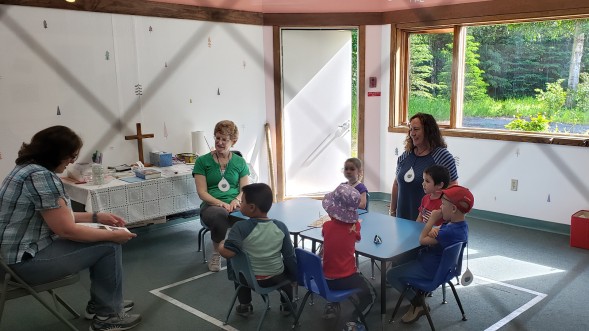Submitted by Rev. Luke Jones, Jewel Lake Parish.
Jewel Lake Parish was birthed from the remnants of an earlier church plant. A union church of the Alaska United Methodist Conference and the Presbytery of Yukon, our name reflects a planned union of three congregations called the “Tri-Anchor Parish.” Although those plans were eventually discarded, they represent the vision of an earlier generation to become “One Church with Many Doors.”

This new incarnation of JLP began in February of 1971. That first month, we opened our doors to provide space for community programs. Beginning with a scout troop, we have continued to open our doors. Today groups as diverse as Twelve Step programs and the Society for Creative Anachronism make use of our facilities, along with a scout group, quilters, and a Korean Presbyterian congregation.

With these many users comes an administrative headache: keeping track over time of which group representatives have keys to the building. This spring, a series of disturbances occurred on church premises when parents were picking up children from the preschool that uses some of our facilities during the week. Those incidents were more or less benign, but they prompted a security review of our premises in which several vulnerabilities were identified. After discussions with the preschool’s staff, we decided to put keyless (combination) locks on the exterior doors of our worship and education centers. A key advantage (no pun intended) of the new locks is reducing the administrative burden of giving groups access to our facilities. Each group can have a separate combination, and instead of trying to recover keys from groups, we can simply deactivate that combination.
While it’s been said that “Good fences make good neighbors,” locked doors can make it hard to be neighborly. They even make it hard even to receive deliveries! Once we had the new locks, we realized we would need (for the first time) a doorbell. We installed a video doorbell, which allows us to come to the door if someone from the church is on premises. But when no one is around, we are still able, sometimes, to help the visitor remotely!
Doors are attached, of course, to buildings. This year our doors have required a surprising amount of maintenance. When our education center was built, each classroom was equipped with its own door. Over the years, water and snow began to damage some of the entryways, and this year two doors needed to be repaired.

Another door is attached to the shed built by a VIM team in the early 2000s. In the past year, for whatever reason, this shed became a magnet to thieves. Each time the shed was broken in to, we installed a stronger, more secure lock — which only led to more comprehensive vandalism as part of the next break-in. After our lawnmower disappeared, we realized we would no longer be able to store property in the shed. We are currently discussing whether there is any way we could secure the building so it could be used again, and if not, what we should do with it.
A final door provides access to our elevator. JLP’s worship center has a split-level design: the upstairs part is where our worship gatherings take place. Last year, we renovated the downstairs so we could have our Cafe fellowship there. In the 1960s this design wasn’t unusual, but in the intervening decades, our leaders realized it wasn’t very accessible either, and added a lift alongside the stairs. It’s slow, but serviceable, and allows us to accommodate people with mobility challenges. However, the electrical controls are delicate. Periodically, a malfunction takes the lift out of service until a new part can be installed. Service calls can run from $300 to over $1200, so a handful of such breakdowns can be a significant burden for a small church.
But doors don’t define buildings, and buildings don’t define churches. Two ministries illustrate how we have looked outward beyond our own doors to engage our community. One was the Vacation Bible School we offered this summer. It had been several years since the last time we were able to offer a VBS to the community. We weren’t sure we would be able to do so this year, and if so, if there would be any need in the community for it to address. We were surprised and delighted that the answer to both questions was “Yes!”

The other ministry is a mobile food pantry operated by the Alaska Food Bank at another church in our neighborhood. For years, JLP had its own food pantry on our own premises behind our own doors. People came to it very rarely, and our few volunteers were burned out. Four years ago, however, we were asked to supply volunteers at the mobile food pantry. First one agreed to serve, then two, and today, six or eight JLP folks regularly participate. They join volunteers from other churches each Saturday, rain or shine, year round, to serve 140-50 of our neighbors.




Great post, Luke!